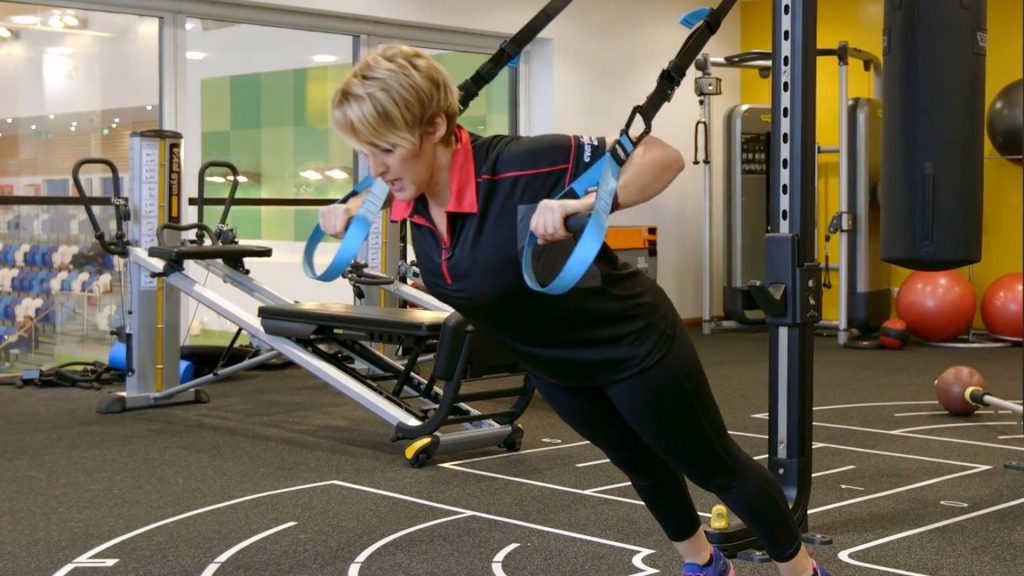The suspension trainer is a fantastically versatile way to use your own body weight to work out in a huge number of different ways. Here, our Master Trainer Sue Wilkie takes us through six different exercises that will help you work on a variety of muscle groups.
Keep reading and watch the videos to find out more about these six suspension trainer exercises that would make great additions to your workout regime.
Six Suspension Trainer Exercises
-
The Plank
Make sure the straps of the suspension trainer are positioned at approximately mid-calf height off the floor and that the handles are at around the same height. You then need to kneel down in front of the suspension trainer, with the straps behind you and put your toes through the straps. Lean forward and place your forearms on the floor, with your shoulders directly above your elbows, which should be bent at 90 degrees.

You must then engage your core, extend your legs backwards and lift your knees to go into a planks position. Hold this for around 20- or 30 seconds, making sure you keep your back flat, your shoulder blades down and your core engaged. To change this exercise up a little, you can try doing the same exercise, but supporting yourself on your palms, with your arms straight.
Benefits of the Plank
As with most plank exercises, this workout is all about your core. It’s brilliant for building strength and stability in your abs, your obliques, your lower back muscles and your glutes too.
-
The Plank Saw

For this exercise, you need to start in exactly the same position as the plank above, straight-backed with your shoulders directly above your elbows. You then push yourself backwards towards the suspension trainer and then pull yourself forward again in a ‘sawing’ motion. Repeat this a few times, making sure you keep that body shape and your core engaged.
Benefits of the Plank Saw
Naturally, this exercise has many of the same benefits as described for the plank above, but it just works those core muscles that little bit harder, helping make sure you’ve got a strong, stable trunk that’s so vital to effective workouts.
-
Hamstring Curl

For this exercise, you need to switch positions on the suspension trainer. Take your feet out of the straps, turn around so you’re facing the suspension trainer and place your heels in the straps. You then need to lie yourself down flat on your back, with your feet directly under the anchor point of the suspension trainer. Then, engage your abs, lift your glutes and bring your heels back towards you and then push them back away from you. To add a little more difficulty to this exercise, try lifting your hips even higher.
Benefits of the Hamstring Curl
Again, this is a great workout for engaging and strengthening your core muscle group, but the most significant effect it will have will be in working your hamstrings and your glutes.
-
Chest Press

For this exercise, you need to make sure the suspension trainer’s straps are fairly long, with the handles at the same height. Next, with your back to the trainer, hold the strap handles and lean forward with straight arms. The harder you want to make the chest press, the more horizontal the starting position needs to be, so to make it trickier, simply move your feet back to the suspension trainer anchor point.
Looking straight ahead, with your arms slightly wider than shoulder width apart drop down towards the strap handles into the chest press position and push yourself back up so your arms are straight. Repeat this 10 or 12 times if you can.
Benefits of the Chest Press
As well as being a great workout for your pectoral muscles, your triceps and shoulders, this exercise is also brilliant for building and strengthening your core stability.
-
The Low Row
Before starting this exercise, we need to adjust the handles on the suspension trainer straps, pulling them up to a medium length, rather than having them long as we have done before. As always, it’s important to ensure the straps are the same length before starting.

To start with, we begin facing the suspension trainer anchor point, leaning back and holding on to the straps. Making sure your arms are straight and your feet, hips, back and shoulders all stay in a straight line, pull yourself up towards the strap handles. The greater the angle you are at and the closer your feet to anchor point, the tougher this exercise will be, so if it gets too hard, just walk backwards a little.
Benefits of the Low Row
As always, this suspension trainer exercise is great for improving your core strength and stability, while the arm movement in this workout will help engage your biceps and your back muscles too.
-
Squat

Begin in the same position as for the low row, with your feet shoulder distance apart, standing straight and then, while supporting yourself with the straps, move into a seated position, with your knees at right angles and with a nice straight line between your knees and your ankles.
Benefits of the Squat
The great thing about using the suspension trainer to perform a squat is that it takes a lot of the pressure off your hips, knees and back. This means you can really concentrate on helping build up the strength in your hamstring and your glutes. Once in this position, stand up again, squeezing your glutes and trying to use the straps as a support only (but still under tension) rather than pulling yourself up with your arms. Repeat this several times to perform a full set.
So check the videos out and learn how to make best use of this fantastically versatile piece of equipment and why not try them out, next time you’re in the gym?